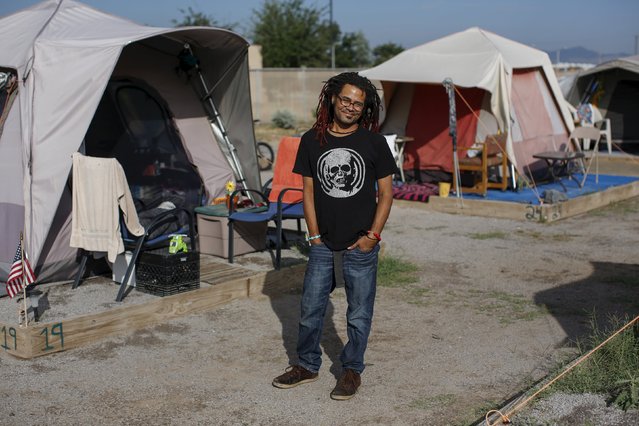
At homeless encampments from Seattle, Washington state to Las Cruces, New Mexico, residents live away from the dangers of life on the streets, saying the stability helps them work towards their goals. Despite a shortage of affordable housing for the poor and budget constraints on social welfare programmes, many U.S. cities have clamped down on tent cities in the past few years. Here: Matt Mercer, a one-time resident of Camp Hope, poses among tents in Las Cruces, New Mexico October 6, 2015. “The most unique thing about the camp is the sense of the community”, said Mercer, a former tent city dweller who now volunteers at Camp Hope. “When you are in the shelter system you don't see community, people are all just in survival mode”. (Photo by Shannon Stapleton/Reuters)
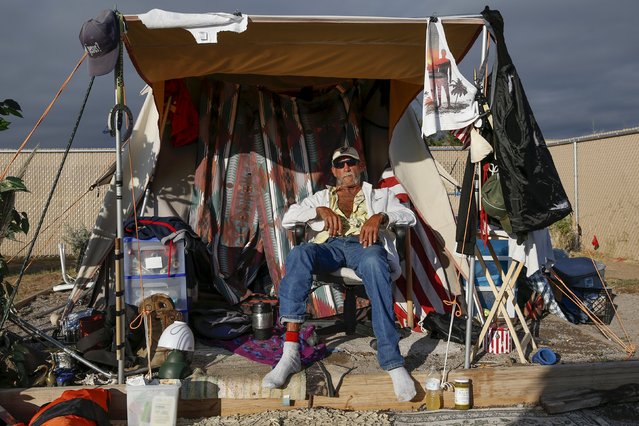
Richey Luper, from Newport Beach, California, sits outside his tent at Camp Hope in Las Cruces, New Mexico October 7, 2015. “This is good ...The tent city gives a sense of safety. No doubt about it”, Luper said. Camp Hope describe themselves as an “alternative transitional living project for the homeless”. (Photo by Shannon Stapleton/Reuters)
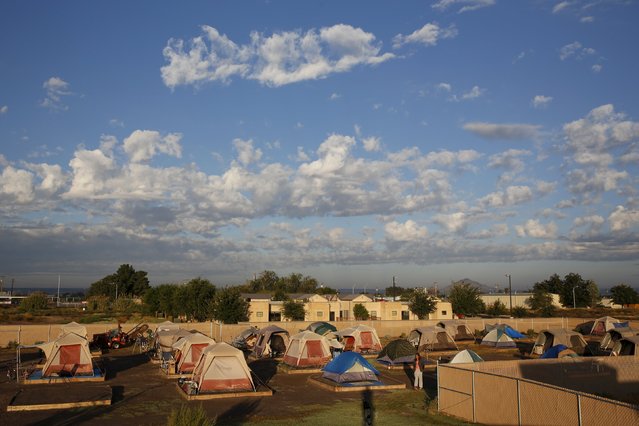
Clouds pass above Camp Hope in Las Cruces, New Mexico October 6, 2015. Camp Hope describe themselves as “alternative transitional living project for the homeless”. Around 50 people live at the camp. At homeless encampments from Seattle, Washington state to Las Cruces, New Mexico, residents live away from the dangers of life on the streets, saying the stability helps them work towards their goals. Despite a shortage of affordable housing for the poor and budget constraints on social welfare programmes, many U.S. cities have clamped down on tent cities in the past few years. (Photo by Shannon Stapleton/Reuters)
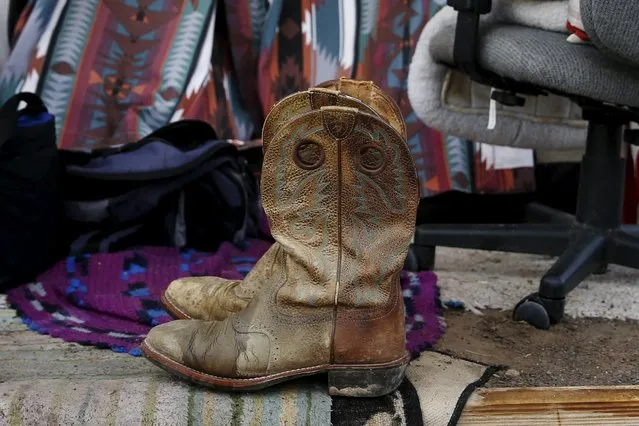
Cowboy boots, a prized possession of Richey Luper, from Newport Beach, California, are seen outside his tent at Camp Hope in Las Cruces, New Mexico October 6, 2015.. (Photo by Shannon Stapleton/Reuters)
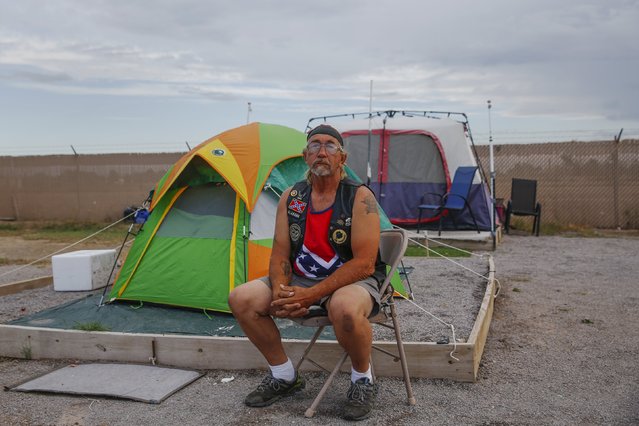
Stanley Smith, 60, from Alabama, sits outside his tent at Camp Hope in Las Cruces, New Mexico October 5, 2015. “The economy isn't getting no better, I don't care what the news says. There is not a person out there that is not one pay-check away from being out here”, Smith said. Smith has moved around the country since the age of 15 and arrived at Camp Hope in 2011. (Photo by Shannon Stapleton/Reuters)
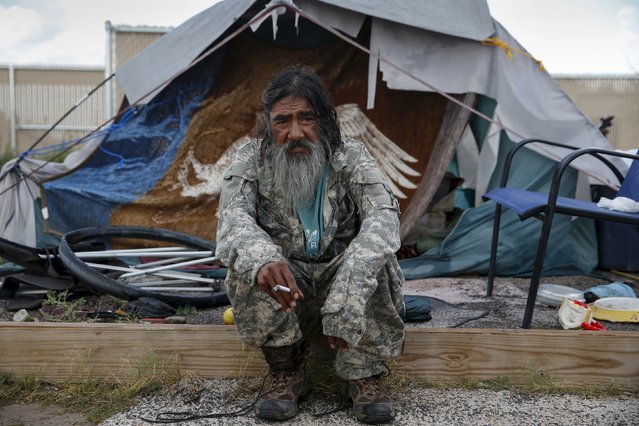
Daniel J. Wabsey, a 58-year-old war veteran, sits outside his tent at Camp Hope in Las Cruces, New Mexico October 6, 2015. “I've been traveling for 35 or 38 years. Getting inside would take a while to get used to. I just want to be able to eat, sleep and be safe. We all get along and understand in Camp Hope. We've all been there. With common sense you can survive out here”, Wabsey said. Camp Hope describe themselves as an “alternative transitional living project for the homeless”. Around 50 people live at the camp. (Photo by Shannon Stapleton/Reuters)
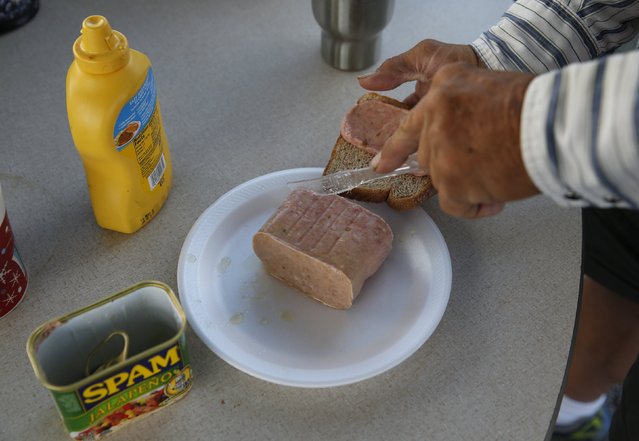
Resident Stanley Smith, 60, from Alabama, cuts spam for a meal at Camp Hope in Las Cruces, New Mexico October 5, 2015. (Photo by Shannon Stapleton/Reuters)
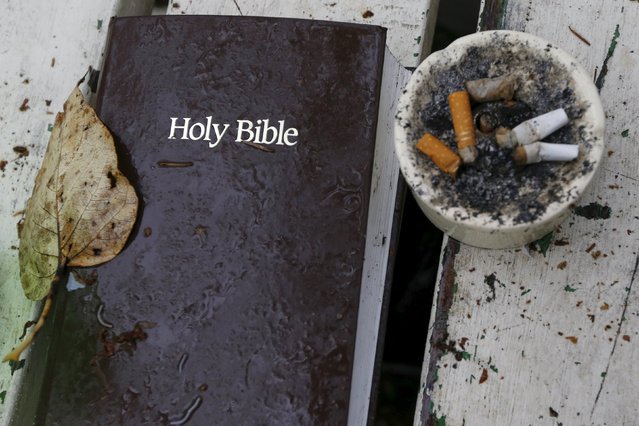
A bible and ashtray filled with cigarettes are seen at SHARE/WHEEL Tent City 4 outside Seattle, Washington October 9, 2015. SHARE and WHEEL describe themselves as self-organised, democratic organisations of homeless and formally homeless people which run several self-managed tent cities. At homeless encampments from Seattle, Washington state to Las Cruces, New Mexico, residents live away from the dangers of life on the streets, saying the stability helps them work towards their goals. Despite a shortage of affordable housing for the poor and budget constraints on social welfare programmes, many U.S. cities have clamped down on tent cities in the past few years. (Photo by Shannon Stapleton/Reuters)
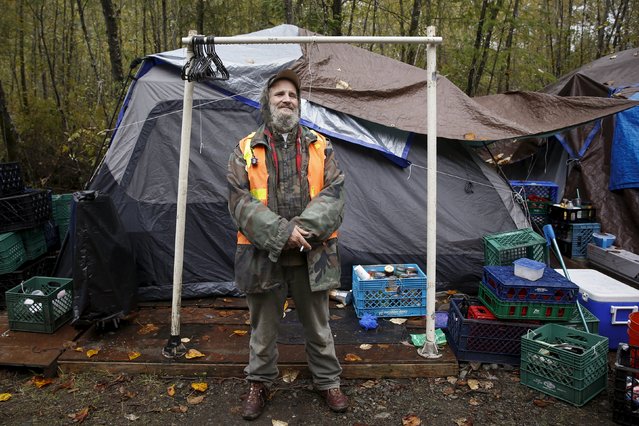
Buzz Chevara, 56, poses in front of his tent at SHARE/WHEEL Tent City 4 outside Seattle, Washington October 9, 2015. “The concept of tent city means community, safety and a place to be where nobody is going to harass or hurt you in the middle of the night”, Chevara said. (Photo by Shannon Stapleton/Reuters)
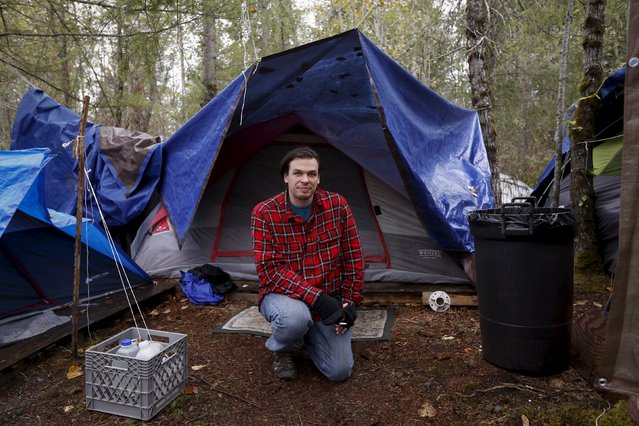
Stephan Schleicher, 31, poses in front of his tent at SHARE/WHEEL Tent City 4 outside Seattle, Washington October 9, 2015. “There is a community here and a sense of people being held accountable to each other”, Schleicher said. (Photo by Shannon Stapleton/Reuters)
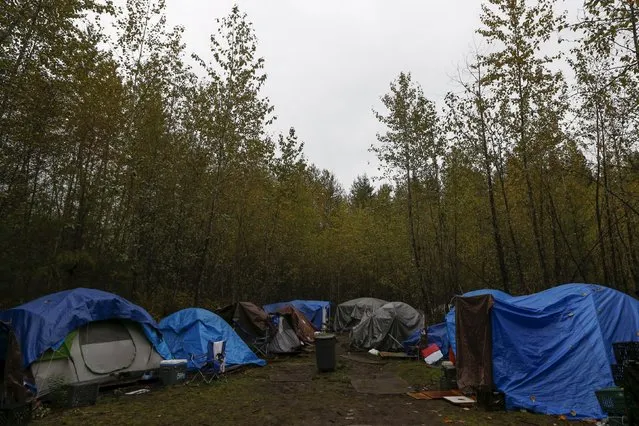
Tents are seen at SHARE/WHEEL Tent City 4 around 35 miles outside Seattle, Washington October 9, 2015. (Photo by Shannon Stapleton/Reuters)
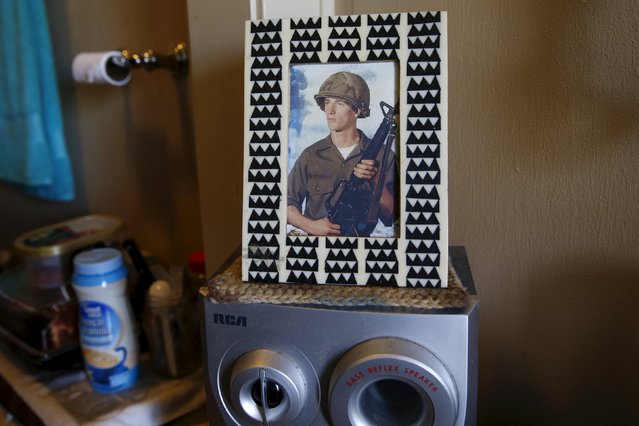
A photograph is seen in a home at Quixote Village in Olympia, Washington October 11, 2015. Quixote Village is made up of 30 cottages, a community building with a kitchen, showers and laundry facilities and a vegetable garden. At homeless encampments from Seattle, Washington state to Las Cruces, New Mexico, residents live away from the dangers of life on the streets, saying the stability helps them work towards their goals. Despite a shortage of affordable housing for the poor and budget constraints on social welfare programmes, many U.S. cities have clamped down on tent cities in the past few years. (Photo by Shannon Stapleton/Reuters)
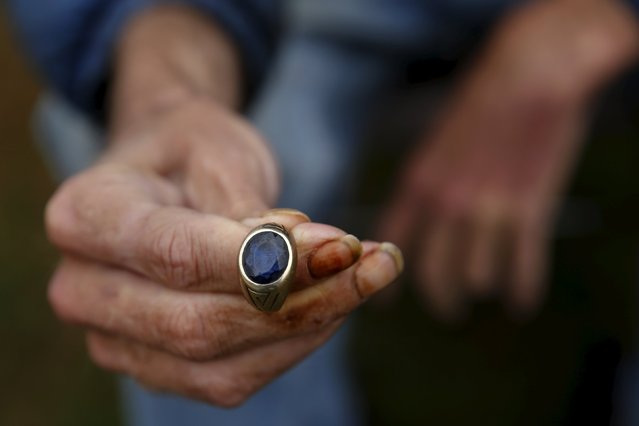
Lantz Rowland, 59, holds a ring as he poses in front of his tent at SHARE/WHEEL Tent City 3 outside Seattle, Washington October 8, 2015. “Homeless people aren't drunken bums with needles shoved in their arms slobbering in a corner. We got people working graveyard shifts, we got kids here, we got families. People go to work not having to carry their stuff on their backs like they do in the indoor shelter system. Tent cities run circles around the traditional shelter system”. (Photo by Shannon Stapleton/Reuters)
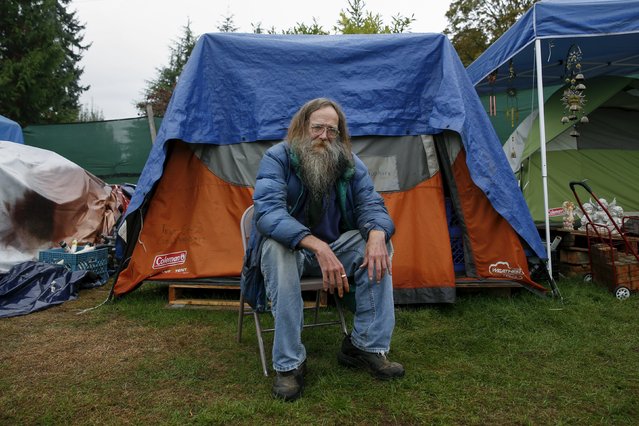
Lantz Rowland, 59 poses in front of his tent at SHARE/WHEEL Tent City 3 outside Seattle, Washington October 8, 2015. (Photo by Shannon Stapleton/Reuters)
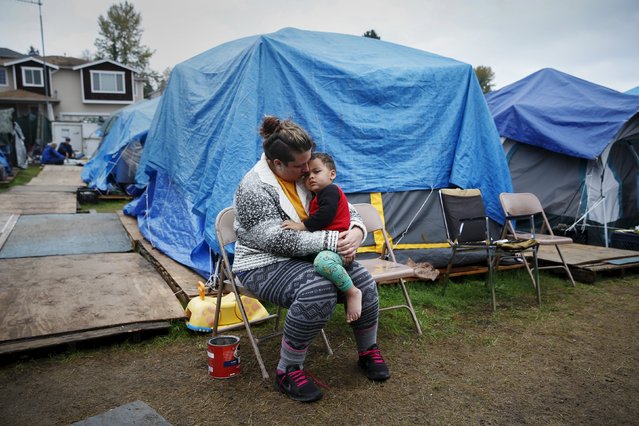
Kadee Ingram, 28, holds her son Sean, 2, at SHARE/WHEEL Tent City 3 outside Seattle, Washington October 13, 2015. Ingram lost her job, and soon afterwards her partner Renee lost her job. “It got (to) the point where we couldn't get a job fast enough and we lost our apartment”, Ingram said. “Coming here, we really like it, being outside especially, we feel safe. We wish we would have known about it sooner”. (Photo by Shannon Stapleton/Reuters)
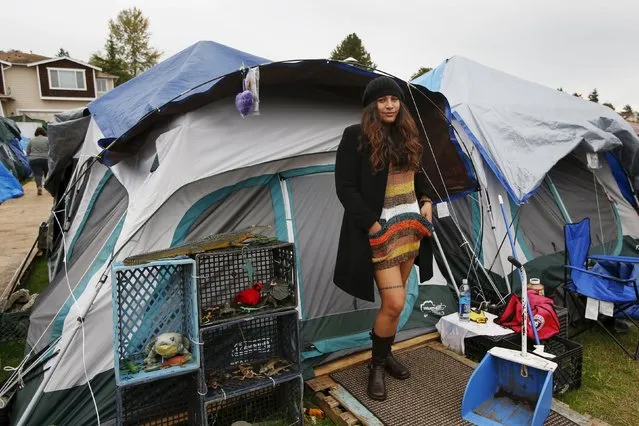
Kalaniopua Young, 32, originally from Hawaii, poses outside her tent at SHARE/WHEEL Tent City 3 outside Seattle, Washington October 12, 2015. “This is a choice I made to live here. I was lonely and depressed living in an apartment. I feel much better here with the social interaction and friendships. There is a direct democracy here with immediate results that differ from traditional bureaucracy”. (Photo by Shannon Stapleton/Reuters)
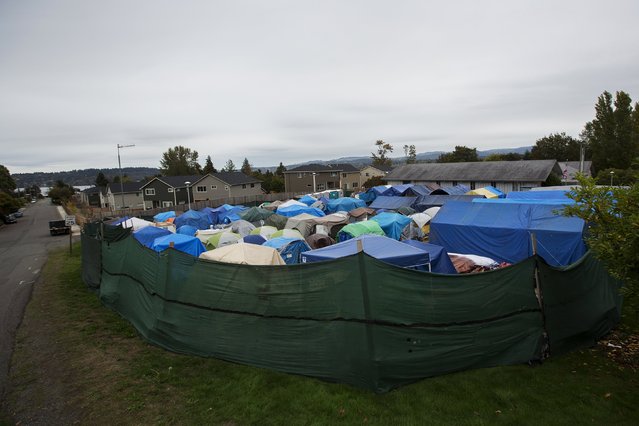
Tents stand at SHARE/WHEEL Tent City 3 outside of Seattle, Washington October 12, 2015. (Photo by Shannon Stapleton/Reuters)
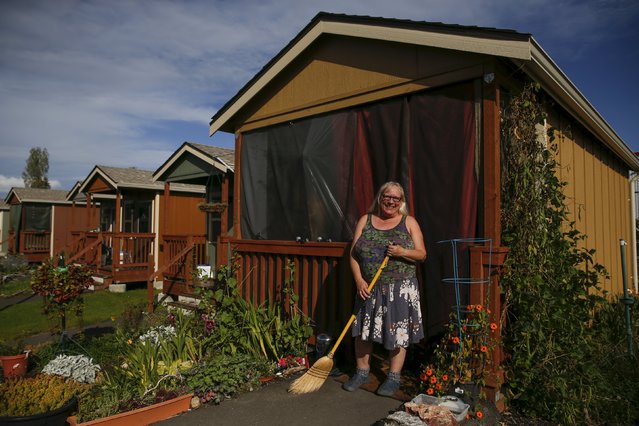
Sharon Wilson, 59, poses outside her cottage in Olympia, Washington October 11, 2015. Quixote Village is made up of 30 cottages, a community building with a kitchen, showers and laundry facilities and a vegetable garden. “Moving inside was a culture shock for a lot of the hardcore campers. I will never forget the first morning we woke up here. One of the residents went outside looking for the outhouse, not realising he had a bathroom”, said Wilson. (Photo by Shannon Stapleton/Reuters)
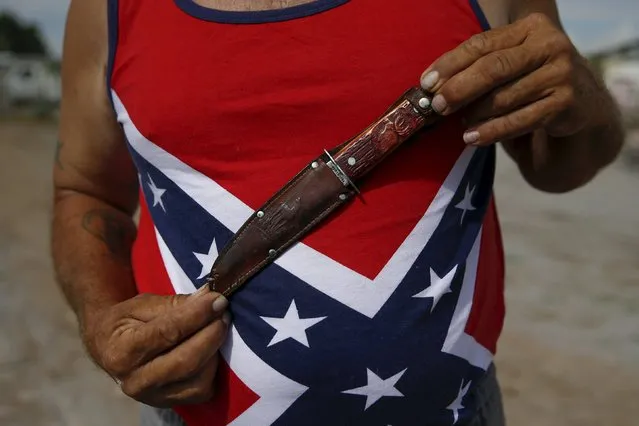
Stanley Smith, 60, from Alabama, holds his prized possession, a buck knife outside his tent at Camp Hope in Las Cruces, New Mexico October 6, 2015. “The economy isn't getting no better, I don't care what the news says. There is not a person out there that is not one pay-check away from being out here”, Smith said. Smith has moved around the country since the age of 15 and arrived at Camp Hope in 2011. (Photo by Shannon Stapleton/Reuters)
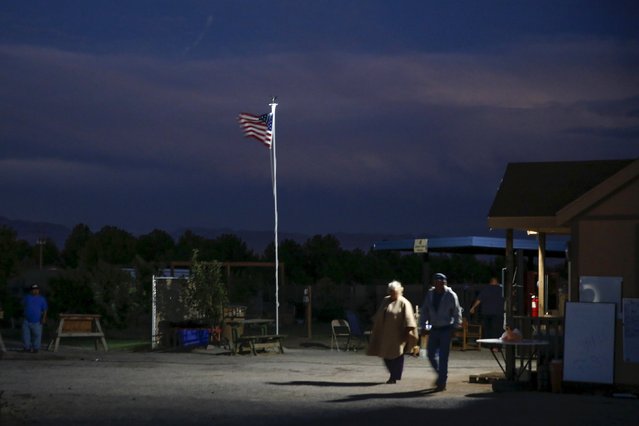
Residents walk at night at Camp Hope in Las Cruces, New Mexico October 5, 2015. (Photo by Shannon Stapleton/Reuters)
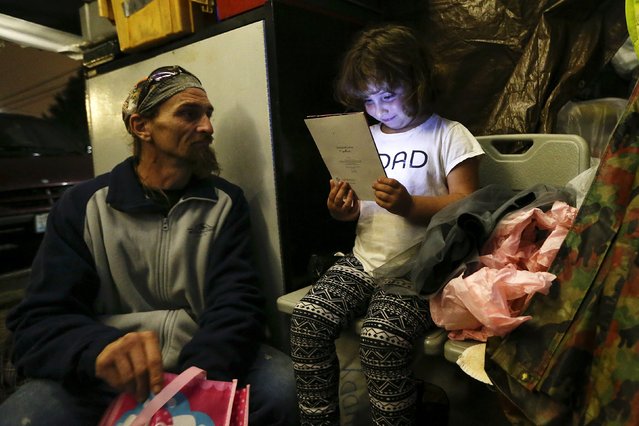
Emma Savage, 6, opens a birthday card given to her by her dad Robert Rowe, 42, a day labourer who had just returned from a 12-hour working day to SHARE/WHEEL Tent City 3 outside Seattle, Washington October 12, 2015. (Photo by Shannon Stapleton/Reuters)
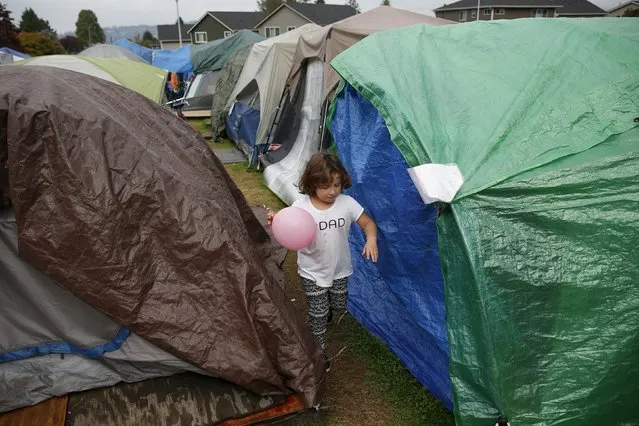
Emma Savage, 6, runs with a balloon between tents at SHARE/WHEEL Tent City 3 outside Seattle, Washington October 13, 2015. (Photo by Shannon Stapleton/Reuters)
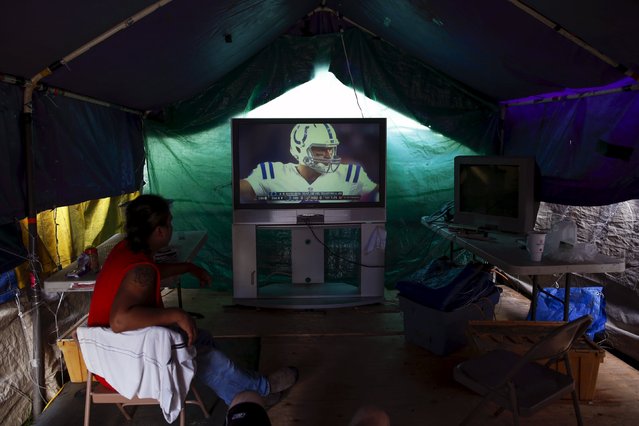
Tent city residents watch an NFL football game in their communal television area at SHARE/WHEEL Tent City 3 outside Seattle, Washington October 8, 2015. (Photo by Shannon Stapleton/Reuters)
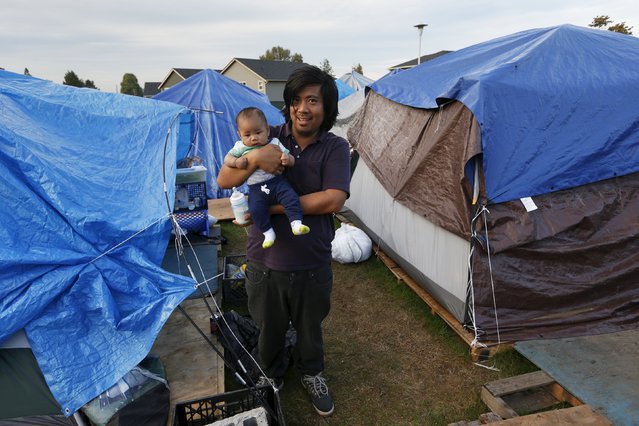
David Yu, 32, poses with his three and a half month old son Joseph, outside his tent at SHARE/WHEEL Tent City 3 outside Seattle, Washington October 8, 2015. (Photo by Shannon Stapleton/Reuters)
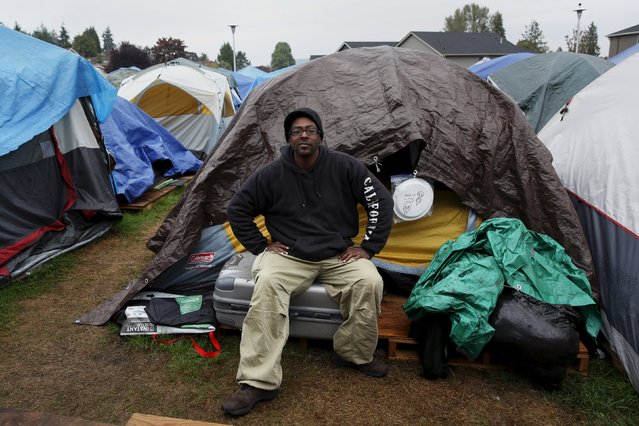
Aaron Ervin, 50, poses in front of his tent at SHARE/WHEEL Tent City 3 outside Seattle, Washington October 8, 2015. “Tent City has been a saving grace for me, a place for me to refresh and gather my thoughts. While I'm here I want to lead by example and be (a) positive influence on camp. People feel safe here, they are tense from being wrongfully judged from carrying all their bags as being homeless and the camp makes you feel comfortable knowing you have a safe place for your belongings, which does a lot for people making them more relaxed”. (Photo by Shannon Stapleton/Reuters)
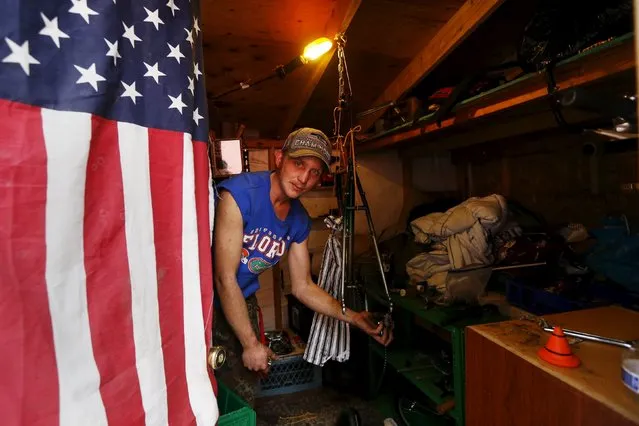
Daniel Paul Oakes, 23, works on a bicycle in his single-room structure at the homeless tent encampment Nickelsville in Seattle, Washington October 12, 2015. “I have been homeless for three and a half years and been at Nickelsville for about 10 months. For the most part everybody gets along. I'd like to have a job that would get me out of here”, Oakes said. (Photo by Shannon Stapleton/Reuters)
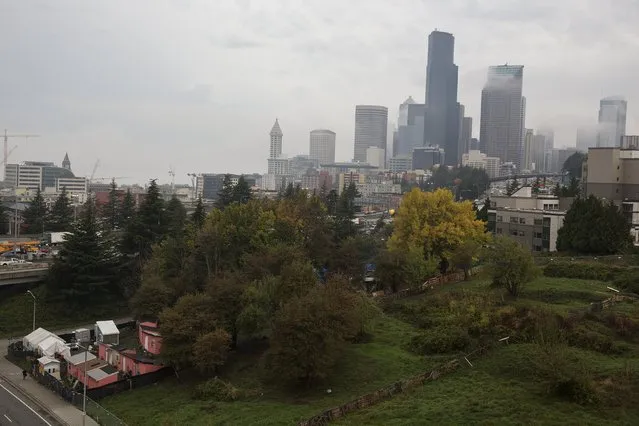
A general view is seen of the unsanctioned homeless tent encampment Nickelsville in Seattle, Washington October 8, 2015. At homeless encampments from Seattle, Washington state to Las Cruces, New Mexico, residents live away from the dangers of life on the streets, saying the stability helps them work towards their goals. Despite a shortage of affordable housing for the poor and budget constraints on social welfare programmes, many U.S. cities have clamped down on tent cities in the past few years. (Photo by Shannon Stapleton/Reuters)
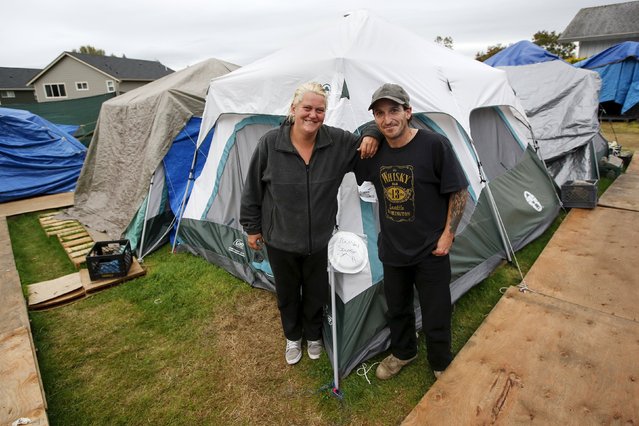
Shane Savage, 41, and his partner Jammie Nichols pose outside their tent at SHARE/WHEEL Tent City 3 outside Seattle, Washington October 12, 2015. (Photo by Shannon Stapleton/Reuters)
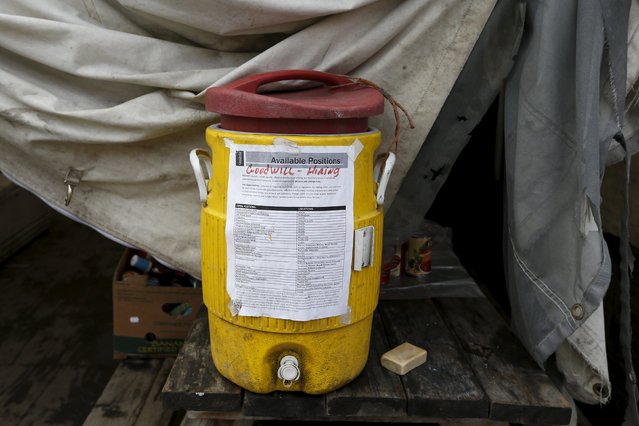
A water cooler is seen at the Nickelsville homeless tent encampment in Seattle, Washington October 13, 2015. (Photo by Shannon Stapleton/Reuters)
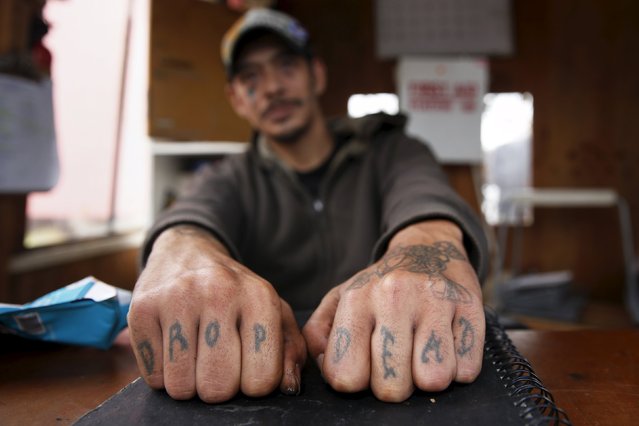
Gary Dumo, 36, shows his tattoos while working security at the homeless tent encampment Nickelsville in Seattle, Washington October 13, 2015. “I'd love to see myself in a home, with working power, electricity, walls and air-conditioned. I'm pretty sure there are more people though that need a place to stay”, Dumo said. (Photo by Shannon Stapleton/Reuters)
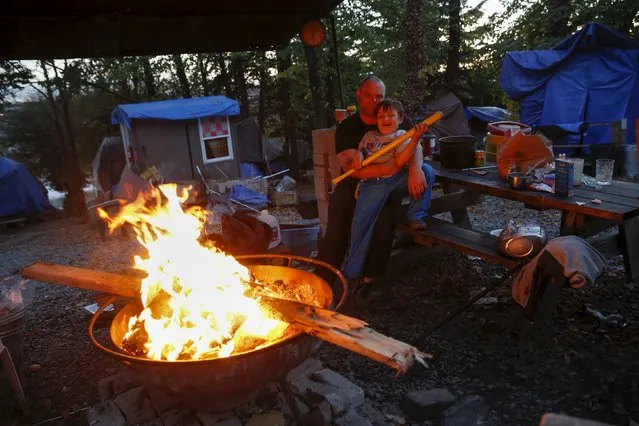
Matt Hannahs, 32, poses with his son Devin outside their tent by a wood fire at Nickelsville homeless tent encampment in Seattle, Washington October 13, 2015. “Devin doesn't view this as a negative thing, I mean being a little boy and resilient he looks at it as an adventure. Just meeting new people and seeing new things its basically like camping. I've always been really grateful that there is some place where you can come and go as you choose and there is safety in numbers. It's like a big family and we look out for each other”, Hannahs said. (Photo by Shannon Stapleton/Reuters)
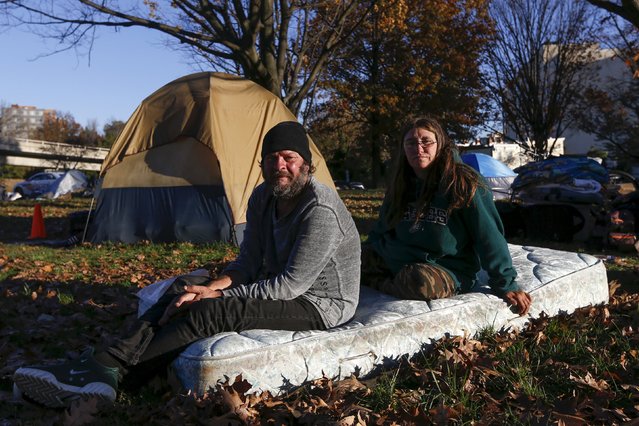
Clyde Burgit and his wife Helen, who have been at the camp for two weeks, sit on a mattress near their tent by the Watergate and Whitehurst Freeway in Washington D.C., November 16, 2015. “Everybody looks out for everybody, this was great and everybody gets along”, Clyde said. On November 20, 2015 the residents were evicted from the area, according to local reports. (Photo by Shannon Stapleton/Reuters)
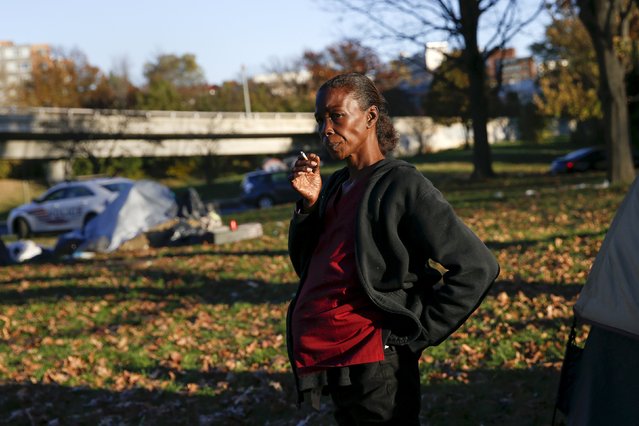
Lovenia Evans, who is pregnant, smokes a cigarette by her tent between the Watergate and Whitehurst Freeway in Washington D.C., November 16, 2015. “This is my second week in this tent, it's better to be here than laying on the street or sidewalk. I'm pregnant and they would like to me to come off the street”, Evans said. (Photo by Shannon Stapleton/Reuters)
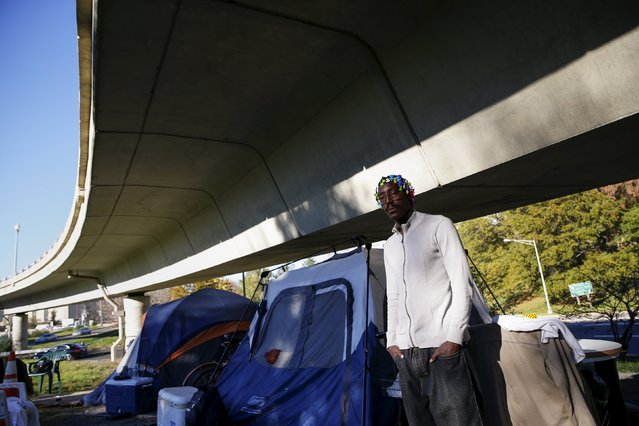
James Bannister, 38, stands by his tent near the Watergate and Whitehurst Freeway in Washington D.C., November 16, 2015. “Tent city is the idea that you can be in a place that is peaceful and quiet and away from everybody else, where you don't have any violence, no problems or none of the above. I'm on the list for housing but have been on the list for 20 years”, Bannister said. (Photo by Shannon Stapleton/Reuters)
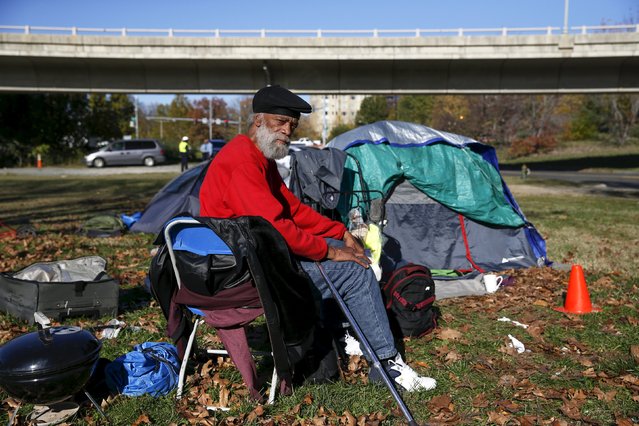
Owen Makel, 65, who has been homeless for nearly 14 years and has lived at the camp for four months, sits by his tent between the Watergate and Whitehurst Freeway in Washington D.C., November 16, 2015. “You have to understand this: we people as homeless have lives, just like you all have lives. We don't want to be out on the street but we don't have an alternative. People have no other place to go”, Makel said. (Photo by Shannon Stapleton/Reuters)
19 Dec 2015 08:05:00,
post received
0 comments
